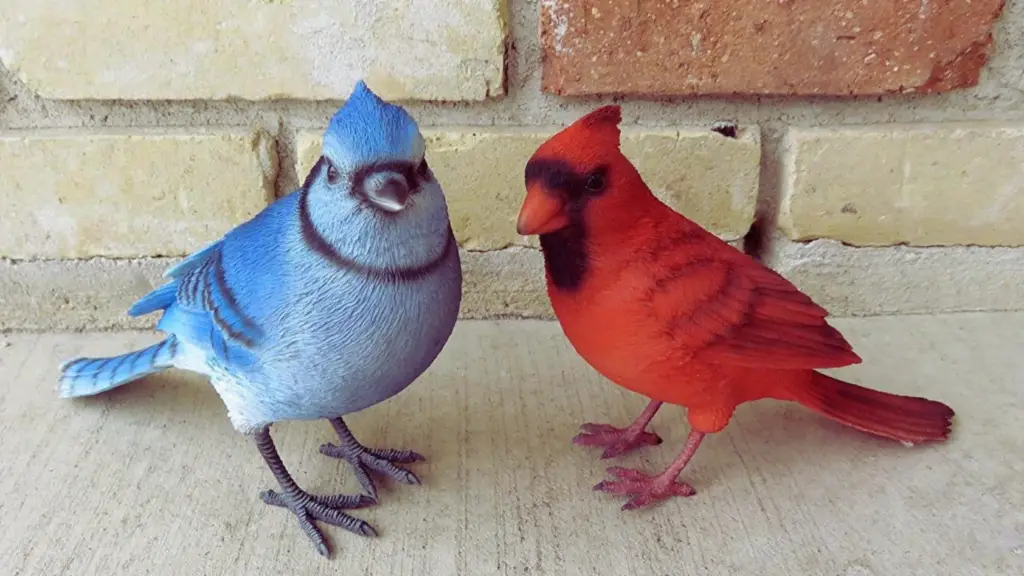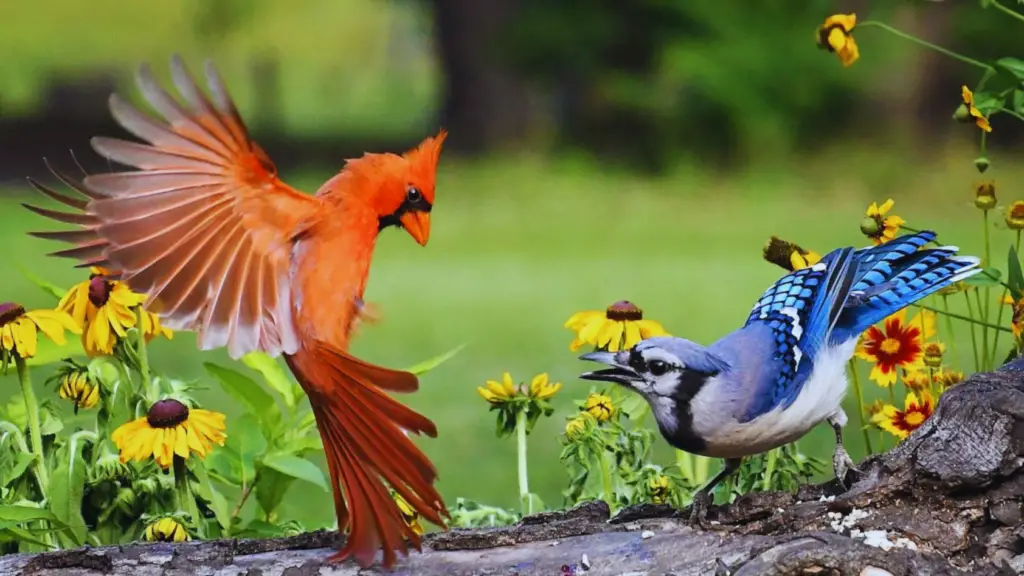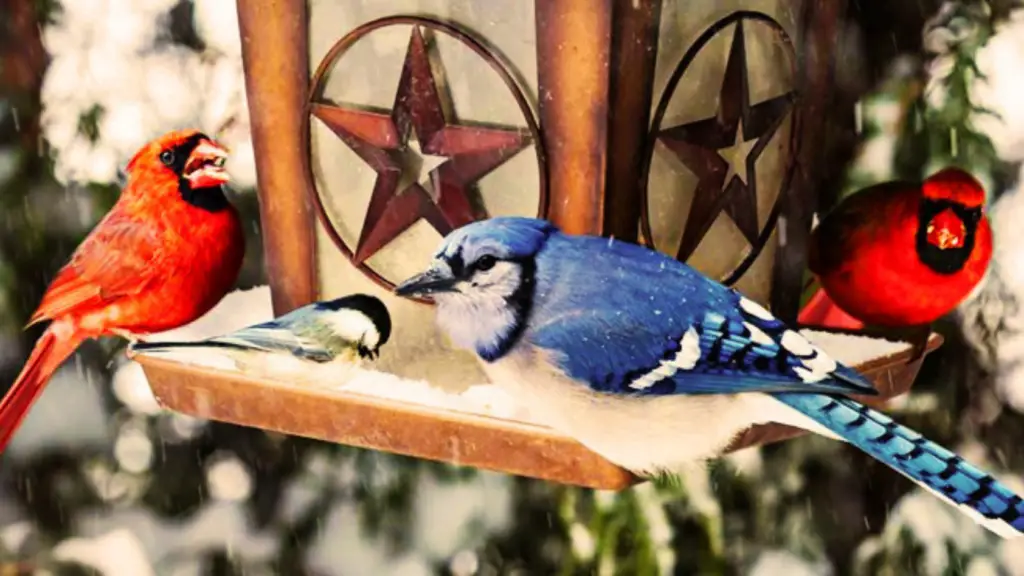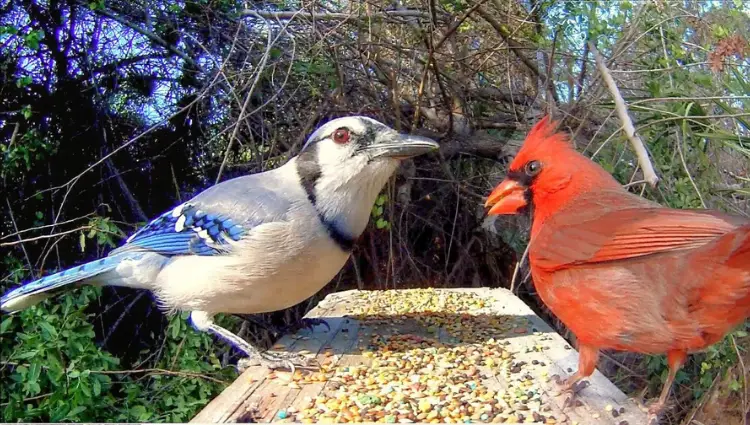When it comes to the world of birds, few rivalries are as colorful or combative as that of the Blue Jay and Cardinal. These winged adversaries both boast strikingly distinct colors and plumage, making them easy to spot in their respective habitats. From their behaviors to vocalizations, each bird has its unique traits that contribute to their ongoing rivalry.
Blue Jay vs Cardinal: A Brief Overview
The blue jay and the cardinal are both members of the avian family, but they belong to different genera. The blue jay (Cyanocitta cristata) is part of the Corvidae family, while the cardinal (Cardinalis cardinalis) belongs to the Cardinalidae family. Let’s explore these two species in detail to understand their unique features and characteristics.
Physical Characteristics
Size and Appearance
The blue jay is a medium-sized bird, measuring approximately 9 to 12 inches in length. It has a robust body with a prominent crest on its head. The plumage of a blue jay primarily consists of blue feathers on the upper body, white feathers on the belly, and black markings on its wings and tail. Additionally, blue jays have striking blue eyes.
On the other hand, cardinals are slightly smaller, ranging from 8 to 9 inches in length. Male cardinals are known for their vibrant red plumage, with a black mask around their face. Female cardinals have a more subdued appearance, with a mixture of gray, brown, and red feathers. Both male and female cardinals have distinctive crests on their heads.
Coloration
Blue jays get their name from their predominant blue color. The shade of blue can vary slightly among individuals, with some displaying a brighter blue hue than others. The white underparts create a striking contrast against the blue feathers. Blue jays also have black bars on their wings and tail feathers.
Cardinals are renowned for their bright red plumage. Male cardinals sport vibrant red feathers, which help them attract mates and defend their territories. Female cardinals, on the other hand, have a more muted coloration to provide better camouflage when nesting.
Beak
The beak of a blue jay is robust and slightly curved. It is well-suited for cracking open nuts and acorns, which form a significant part of their diet. The beak is black in color and allows blue jays to forage efficiently.
Cardinals have a distinctive cone-shaped beak. The beak is orange-red in males and grayish in females. The shape of the beak enables cardinals to feed on a variety of seeds and fruits.
Distinct Colors and Plumage

The Blue Jay and Cardinal are two of the most recognized and iconic birds in North America. One of the most striking features of these birds is their distinct colors and plumage, which has made them avian adversaries for years. The Blue Jay features a vibrant blue color, while the Cardinal boasts a striking red plumage, creating a clash of colors at every encounter.
The Blue Jay has a bold, blue color that covers its entire body, including its crested head and tail. The blue pigment in its feathers is created by the scattering of light, creating a beautiful iridescent effect. On the other hand, the Cardinal is known for its bright red feathers, which are produced by pigments called carotenoids. Adult males have a bright red color, while females are more subdued with a red-brown hue.
Plumage Adversaries
These two species have been recognized as colorful adversaries for years, and their rivalry goes far beyond their physical appearance. The Blue Jay and Cardinal are known for their competitive behavior, and their distinct colors can play a role in their dominance over each other.
| Blue Jay | Cardinal |
|---|---|
| Bold blue color | Bright red plumage |
| Iridescent effect | Pigment produced by carotenoids |
Their feathers of competition make them a sight to behold as they engage in colorful confrontations. Their clash of colors has made them a favorite subject of bird watchers and photographers alike, capturing the beauty of their feathered contest.
Their wings are not the only things clashing, as their behaviors and interactions also contribute to their rivalry. Keep reading to learn more about their habitats, behaviors, vocalizations, and more.
Habitats and Behaviors

Blue Jays and Cardinals have contrasting habitats and behaviors that fuel their avian rivalry. While Blue Jays are commonly found in wooded areas, Cardinals prefer open spaces, such as gardens, fields, and backyards. Blue Jays are known for their fondness for acorns, nuts, and insects. Cardinals, on the other hand, prefer seeds and fruits, including sunflower seeds, safflower seeds, and berries.
| Blue Jay | Cardinal |
|---|---|
| Wooded areas | Open spaces |
| Acorns, nuts, insects | Seeds, fruits, berries |
Blue Jays are also known for their territorial nature, often engaging in aerial showdowns with other birds, including Cardinals. They are known to steal eggs and nestlings of other bird species. Cardinals, on the other hand, are known for their monogamous nature and mating for life. They build nests low in shrubs and trees, often near human settlements.
Blue Jays are highly vocal birds, with a repertoire of calls, including mimicry of hawk calls, which they use to intimidate other birds. Cardinals, too, have a distinctive song, often described as a “cheer cheer cheer” call. Both Blue Jays and Cardinals are known to engage in flock feuds, with several birds from one species attacking a single bird from the other species.
Overall, the habitats and behaviors of Blue Jays and Cardinals contribute to their ongoing rivalry in the bird world. While they may share some similarities, their differences are what make them unique and fascinating to observe.
Vocalizations and Interactions
Blue Jays and Cardinals are not just known for their distinct colors and habitats but also for their unique vocalizations and interactions with other birds.
Dueling Songbirds
Blue Jays are highly vocal birds and often mimic the calls of other species. They have a signature “jay-jay” call that is loud and harsh, making it difficult to ignore. Blue Jays also produce a variety of other calls and songs, including whistles, rattles, and gurgles. They are known to duet with their mates, creating a harmonious blend of different sounds.
On the other hand, Cardinals are known for their beautiful songs, which are often described as whistling phrases. Cardinals have a wide repertoire of songs, and they are known to sing throughout the day, especially during breeding season. They also have a distinctive “chirp” call that is sharp and clear.
The dueling vocalizations of Blue Jays and Cardinals can often be heard in the same area, creating a symphony of sounds that is unique to each species.
Blue Jay vs Cardinal: Flock Feuds

Blue Jays and Cardinals are both territorial birds and can be aggressive towards other birds, especially during breeding season.
Blue Jays are known to form large flocks during the winter months, where they can often be seen chasing other birds away from food sources and nesting areas. Cardinals, on the other hand, are more solitary birds, with pairs defending their nesting territories fiercely.
When Blue Jays and Cardinals cross paths, they can often engage in vocal and physical confrontations. While Blue Jays are known to be more aggressive, Cardinals are not to be underestimated, as they can hold their own against their larger rivals.
Feathered Contest
The interactions between Blue Jays and Cardinals can be seen as a feathered contest, with each species trying to establish dominance over the other.
Blue Jays are known to steal food and eggs from other birds, including Cardinals, while Cardinals defend their nests and territories from all intruders.
Despite their ongoing rivalry, Blue Jays and Cardinals coexist in the same habitats and play an important role in maintaining the balance of the ecosystem.
Reproduction and Nesting
Blue Jay Reproduction and Nesting
Blue jays typically mate for life and form monogamous pairs. They build their nests in the forks of trees or on horizontal branches. The nest is constructed using twigs, grass, and other plant materials, and it provides a secure place for incubating eggs.
Female blue jays lay a clutch of 2 to 7 eggs, which are incubated by both parents for approximately 17 to 18 days. After hatching, the chicks are cared for by both parents, who bring them food until they are ready to fledge.
Cardinal Reproduction and Nesting
Cardinals also mate for life and establish breeding territories. The male cardinal sings to attract a mate and defend his territory from other males. Once a pair forms, they build a cup-shaped nest using twigs, leaves, and grass. The nest is usually situated in dense vegetation, providing protection from predators.
Female cardinals lay a clutch of 2 to 5 eggs, which are incubated by the female for about 11 to 13 days. Both parents participate in feeding the chicks until they are ready to leave the nest, which typically occurs after 9 to 11 days.
Interactions with Humans

Blue Jay and Humans
Blue jays are frequent visitors to backyard bird feeders, where they enjoy consuming seeds and suet. Their striking blue color and lively behavior make them a favorite among birdwatchers. However, blue jays can be aggressive toward other bird species and may chase them away from feeders.
Cardinals and Humans
Cardinals are beloved by many bird enthusiasts for their bright plumage and melodious songs. They are a common sight in residential areas, especially those with ample vegetation. Cardinals are known to visit bird feeders, delighting homeowners with their presence.
Conservation Status
Both blue jays and cardinals are considered species of least concern in terms of conservation status. They have stable populations and are not currently facing any significant threats. However, habitat loss and fragmentation can impact their numbers locally.
It is important for humans to preserve and protect the natural habitats of these birds to ensure their continued presence in our ecosystems.
Conclusion
The blue jay and the cardinal are two remarkable bird species with their own unique characteristics. While the blue jay captivates with its bold blue plumage and raucous calls, the cardinal enchants with its vibrant red feathers and melodious songs. Both birds add beauty and liveliness to our natural surroundings.
Understanding their physical traits, habitat preferences, behavior, and feeding habits allows us to appreciate these avian wonders even more. Let us continue to cherish and protect these magnificent birds and ensure their presence in our ecosystems for generations to come.
Blue Jay vs Cardinal FAQs
Q: How long do Blue Jays and Cardinals live?
A: On average, Blue Jays live for 6-7 years in the wild, but can live up to 26 years in captivity. Cardinals typically live for 3-4 years in the wild, but can live up to 15 years in captivity.
Q: Do Blue Jays and Cardinals migrate?
A: Blue Jays are migratory birds and can be found in different parts of North America depending on the season. Cardinals, on the other hand, are non-migratory and can be found year-round in their preferred habitats.
Q: Are Blue Jays and Cardinals aggressive towards humans?
A: Blue Jays and Cardinals are generally not aggressive towards humans unless they feel threatened or their young are in danger. However, it is important to remember to not approach or harass any wild animals.
Q: How do Blue Jays and Cardinals compare to other bird species?
Blue Jays vs other bird species:
Blue Jays are known for their intelligence and adaptability. They are also known to be quite vocal and can imitate the sounds of other birds and animals. They are part of the corvid family, which includes crows and ravens.
Cardinals vs other bird species:
Cardinals are known for their striking red plumage, which is unique among North American birds. They are part of the finch family, which includes sparrows and goldfinches.













